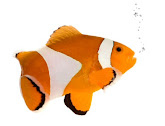The black arowana, Osteoglossum ferreirai, is a freshwater bony fish of the family Osteoglossidae, commonly kept in aquaria. The term "Osteoglossum" means "bone-tongued" and "bicirrhosum" means "two barbels" (from the Greek language).
Description
Its natural habitat is the Amazon river in South America as well as in still waters in Guyana.
It has a long body and a tapered tail and can grow to a maximum size of around 1 m in captivity. In the wild, it has been known to reach over 1.2 m in length. The juveniles are usually a dull silver color with black markings around the head and the tail. Once it reaches about 15 cm, the markings will disappear and it will start obtain the silvery color, hence its common name.
The species is also called water monkey or the "monkey fish", because it can literally jump out of the water and capture its prey. It usually swims near the water surface awaiting for potential prey. Although it has been known to eat larger prey like small bats and birds and even small monkeys, their main diets consist of shrimps, insects, smaller fishes and other animals that float on the water surface, on which its draw-bridge-like mouth is exclusively adapted for feeding.
Arowana are also called "dragonfish" by aquarists because of their shiny armor-like scales, which are similar to the Asian’s folklore of dragons.
In the aquarium
Tank size
It is important to have a large enough tank to keep these large fishes. The minimum tank size for one Arowana for life is a 96"L x 36"Wx 36"H or 538 gal aquarium . As it grows, a larger tank will be necessary to insure the maximum length and life span of the Arowana. The tank must have a sturdy lid, as these fish are active jumpers and will jump out of the tank and die.
Water conditions
Water conditions are important for Arowanas. Some black water additives can help simulate the Arowana’s natural habit.
Black arowanas can adapt to most water supply and thrive
Temperature - 24°C to 28°C, but best at 26°C
Also a 25-30% water change is necessary 1-2 times every week to maintain excellent water conditions.
Feeding
It is very important that you do not overfeed Arowana when they’re young, because as they grow, they might develop drop eye. Arowanas will eat insects, shrimp, pellets, live fish, beef heart, frogs, etc. The best diet for Arowanas is pellets, live crickets, and shrimps. Small feeder fish are often raised in poor conditions and can carry many diseases transmittable to predatory fishes.
Tank mates
Any fish will do as long as it doesn’t fit in the Arowana’s mouth. Many people like having more than one Arowana in the tank, that’s fine and all but they must be at least 5-6 or more in the tank at a time because Arowanas are very aggressive towards each other.
References
Osteoglossum ferreirai (TSN 161896). Integrated Taxonomic Information System. Retrieved on 19 March 2006.
"Osteoglossum ferreirai". FishBase. Ed. Ranier Froese and Daniel Pauly. November 2005 version. N.p.: FishBase, 2005.



